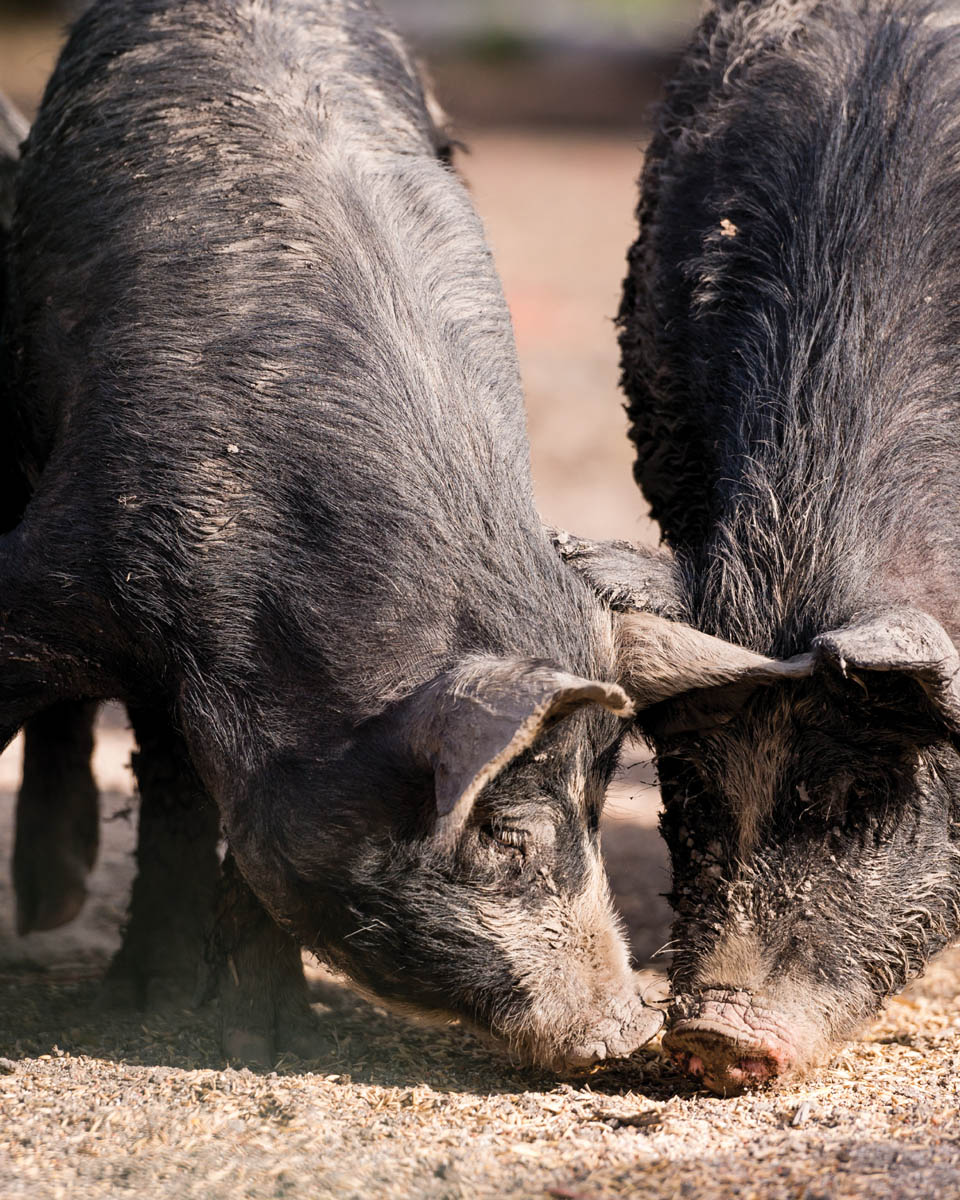

Unlike ruminants (sheep, cattle, goats) and cecal fermenters (horses), swine cannot derive enough energy from pasture forage alone to meet their entire nutritional requirements. They must be supplemented with more concentrated feeds such as grain.
This does not mean, however, that pasture cannot be a valuable component of a swine diet. Prior to World War II, pasture or forage of some sort was considered essential to the diet of swine, as it supplied necessary vitamins and minerals not found in grains. The development of synthetic vitamins and purified mineral supplements made pasture unnecessary and the rearing of pigs in confinement possible.
Because concrete, iron, and machinery were all cheap in the post–World War II era, there was a mad rush to confinement. Raising hogs changed from a low-overhead, low-volume business to a high-overhead, high-volume business. Now, there is a desire among many people to consume pork raised in a more natural setting. Some believe it more humane to raise pigs in that manner, some believe that it is healthier to consume, and others find pork raised on pasture to simply be more flavorful than pigs raised in confinement.
When I was a kid, we raised pigs outdoors, at least for most of their lives. This outdoor existence opened up many nutritional opportunities for pigs not found in confinement. Many of these advantages came from sources other than the forage. In one pasture, we had a grove of walnut trees, and soon after Dad turned the sows out in the morning in the fall you could hear sows cracking walnuts in their teeth. If you have ever tried to crack a black walnut, you gain an appreciation for how strong a sow’s jaws are. When we went fishing, the sows got all the fish heads and fish guts. No matter how inedible and disgusting we regard fish heads, sows seem to consider them to be quite tasty. You want to start a fight in a sow herd, toss one single fish head out to two or more sows. There are also worms, grubs, and insects for a nice boost of protein.
Surprisingly, one of the nutritional advantages of pasture comes from the soil itself. Sow milk is very low in iron, not rich enough to provide the needs for suckling pigs. Piglets in confinement are given an injection of iron to meet their needs; piglets on pasture get their iron from eating soil during rooting. This is the reason the meat from pasture-raised pigs is usually a dark red color, rather than the pale white color of confinement-raised pigs. It has a higher iron content, and the red color comes from myoglobin, a compound similar to the red hemoglobin in blood. Since much of the adult female human population in the United States is chronically iron- deficient, this is a distinct nutritional advantage of pasture-raised pork over confinement-raised pork.
Another nutritional benefit to swine on pasture occurs if they are copastured with a ruminant, and that is the consumption of the ruminant manure by the pigs. While this sounds completely disgusting to a lot of people, the manure the pigs ingest comes no closer to the meat than the manure the pigs themselves produce.
Because ruminant manure is a product of fermentation, it is rich in vitamin B-12 (which is required by swine and is not found in any plant material) as well as many other vitamins. If the ruminant is fed grain, a certain percentage of this grain comes through in the manure and is relished by the pigs. This “pass-through” feeding system is so successful that at one time it was standard practice in the Corn Belt to put one weaned pig per steer in the small feedlot found on nearly every farm. The pigs in this system needed very little supplemental feed, so the gain was essentially free. This practice, though quite profitable, declined in popularity with the advent of fence-line feed bunks, which are not hog tight, and the use of feedlot diets containing monensin, which is toxic to hogs.
Confinement-raised pigs are fed a scientifically balanced diet that meets their nutritional needs to a very exact degree; they are far from malnourished. Let me be clear on this point: I don’t think confinement hogs are abused any more than people living in temperature-controlled apartment complexes and given free food every day of their lives are abused. But they are also not fed nutrients in excess, because to do so is expensive and does not increase pig growth. With a pasture-raised pig, however, many nutrients are supplied in excess quantities at no additional cost, with the aforementioned iron being one example. Many of the fat-soluble vitamins (A, D, E, K) are abundant on pasture and stored in the fat of the animal.
I believe this confers advantages to those consuming this fat. It is also quite likely that the many diverse nutritional sources found on pasture contribute as-of-yet undiscovered nutrients that may be quite beneficial to both hog and human health.
Pasture is much more valuable as a feed source for mature sows and boars than for finishing pigs. Although rich in vitamins and minerals, pasture is a poor source of energy for swine because there is only a limited amount of fiber breakdown in their monogastric digestive system. As swine mature, however, the value of forage increases to them. Mature sows, if fed forage continuously as some portion of their diet, will develop populations of fiber-digesting microbes in their large intestine. They will still not be able to meet all their needs on pasture alone, but they will be able to derive more and more energy from pasture forage as they age.
Mature sows in gestation have rather low energy requirements and forage can form a large percentage of their diet; if allowed to eat all the grain they want, sows will get too fat to give birth safely.
Another advantage of allowing sows to eat all the pasture they want during gestation is that it keeps their stomach stretched, so that once they give birth and they need to cram all the energy they can into themselves, they have a larger intake capacity than a limit-fed sow.
Pasturing pork can offer advantages to the pasture as well, but only if well managed. Since most of the feed for swine is imported to the pasture through their grain ration, the manure of the pigs contains nutrients that did not originate from the pasture itself, and feeding swine on pasture amounts to a tremendous fertility transfer to the pasture. On the other hand, because pigs can dig and root up pastures, they can also destroy a pasture if left in one place too long. When pigs were commonly pastured decades ago, farmers put rings in their hogs’ noses to prevent rooting. Rotational grazing with frequent moves can also limit rooting.
There are anecdotal reports that hog rooting can be prevented by giving the pigs feed of animal origin, such as meat and bone meal or fish meal. Apparently, it is a desire for animal protein (in the form of grubs and worms) that leads hogs to begin churning up pasture sod. This rooting tendency of pigs can also be put to use. A pasture in need of renovation can be fenced and hogs placed on it, until the sod is destroyed, and a blank slate is available for seeding. One advantage of hogs is that they can be used to “root-o-till” areas that are too rocky or too brushy for tillage equipment. Hogs can even be used to uproot stumps by digging a few holes around the roots and tossing cull apples in the holes. Best of all, they work for free.
Swine pastures should be rotationally grazed. This allows pastures to recover from grazing and reduces rooting. Rotational grazing also reduces the risk of internal parasites. Rest intervals between grazing should be a month or longer to interfere with the life cycle of the parasites.
A “new” way of producing pork on pasture is to take advantage of fruit- and nut-producing trees in the pasture. Fallen fruits, nuts, and acorns can form a very large percentage of the diet. I have a friend, Ryan Carlgren, who has swine pastures containing huge bur oak trees, and he rotates the pigs to these pastures during acorn drop so the trees furnish him about a month of free feed in the fall. This is the swine-finishing method used to produce the famous jamon iberico de bellota hams produced in the Dehesa region of Spain and Portugal. Apparently, acorns impart a particular flavor to the pork that is in demand by chefs at upscale restaurants. Ryan tells me his pork does have a unique and delicious flavor.
This concept of producing both a crop of swine feed and a forage crop from the same acre was the standard way of raising swine before mechanization and confinement feeding made it “obsolete.” In centuries past, the pigs were just turned out to free-range and glean whatever feed they could on their own. In the future, we may be designing pastures to produce a bonus crop of swine food, with fruit trees, nut trees, and oak trees planted at widely spaced intervals across pastures, with an understory of shade-tolerant grasses, legumes, and forbs. The trees would be selected to drop fruits, nuts, or acorns in sequence so swine feed is provided for as long as possible throughout the season. This concept is further discussed in chapter 11.
Swine can also glean grain missed by the combine, particularly if there is a cover crop seeded in the field. Beef cows are often used to pasture stubble fields, but they are rather inefficient at harvesting the spilled grain unless it is still attached to ears of corn. Even if cows do eat ears of corn, a large percentage of the kernels pass through them undigested and are deposited in a nice warm pile mixed with a vitamin-rich sauce that is eagerly consumed by pigs copastured with cattle.
Some breeds of swine are better suited to pasture than others. Most modern swine breeds have been bred to do well in confinement, but a few breeds, such as Tamworth, Duroc, Chester White, Hampshire, Large Black, Yorkshire, Poland China, Gloucestershire, and Berkshire have continued to be selected for ability to do well on pasture. Some exotic breeds reputed to do well on pasture include Mangalitsa (a furry breed of hog adapted to colder weather), Ossabaw Island (derived from a wild hog population on an island off the Atlantic coast), Saddleback, Guinea Hog, Choctaw, Mulefoot, and Red Wattle. Whatever the breed, pigs’ prior experience in pasture situations similar to your own is valuable. Pigs taken from a tropical island that are used to eating fallen bananas would be lost on a clover pasture with a trough full of ground corn.
The percentage of the total swine diet supplied by pasture varies by production stage. Gestating sows can receive a large percentage of their diet from pasture, while finishing pigs and lactating sows function best when forage is roughly 10 percent of the total diet by dry weight. At a level of 10 percent, good-quality pasture can act as a source of many vitamins and minerals, as well as some protein, without greatly diluting the energy content of the diet.
Each ton of available forage production should be enough green feed for a season for about five finishing pigs also receiving a full feed of a grain ration, or two lactating sows with litters receiving a full grain ration, or one gestating sow that is limit fed. It is common in the humid areas of the United States (more than 30 inches of annual rainfall) for an acre of legume-dominant pasture producing 4 tons of forage per acre to carry 15 to 20 finishing pigs or 5 to 10 lactating sows per acre as long as they are fed a full grain ration in addition to their forage allotment. Lactating sows and finishing pigs should be fed a grain ration to appetite, and gestating sows should be limit fed about 4 pounds of complete ration on pasture daily.
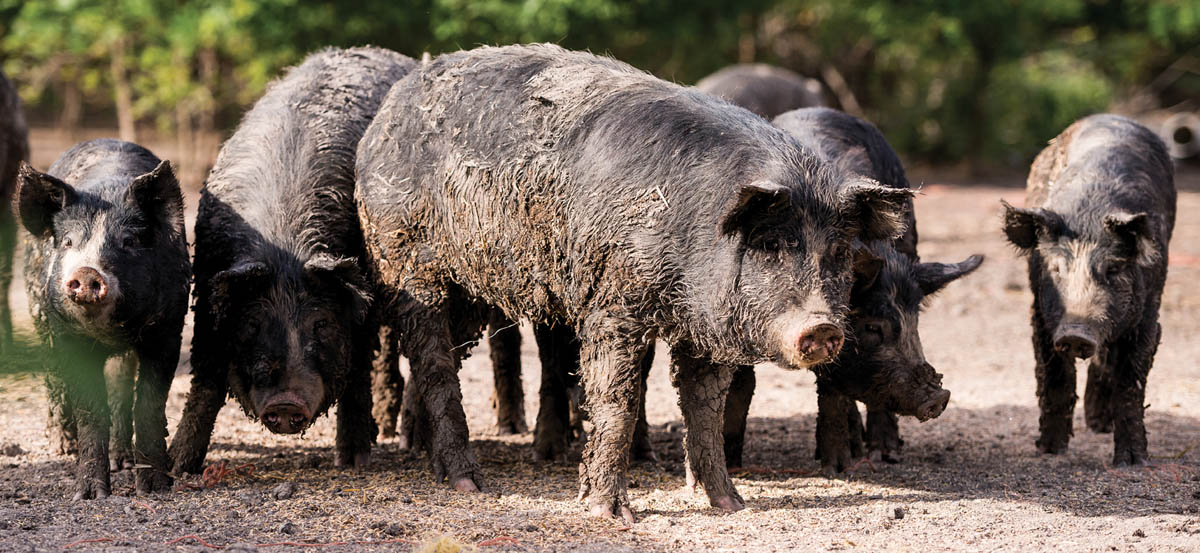
These Berkshires are an excellent breed for a pastured swine operation.
Good-quality, vegetative pasture can supply most of the vitamin and mineral requirements of swine, along with about half the protein supplement. Since the vitamin, mineral, and protein are the expensive parts of the ration, this can make feeding pigs on pasture quite economical.
Alternatively (but less economically), swine on pasture can simply be fed the same ration as swine in confinement. Little modern information is available on formulating rations for pigs on pasture, since it is so uncommon these days, and small individual pasture pork producers tend to not make large donations to land-grant agricultural colleges. Luckily, long ago I acquired a copy of Feeds and Feeding, a textbook by F. B. Morrison from 1938, the authoritative reference on feeding swine in the preconfinement era. Here are some suggested rations for swine on pasture from that classic text.
|
Adult swine |
Weaned pigs to 50 pounds |
Finishing pigs, 50–100 pounds |
Finishing pigs, 100 pounds+ |
|
|---|---|---|---|---|
|
Corn or sorghum |
92 percent |
75 percent |
88 percent |
92 percent |
|
Animal protein source (such as meat scraps or fish meal) |
4 percent |
15 percent |
6 percent |
4 percent |
|
Soybean meal |
4 percent |
10 percent |
6 percent |
4 percent |
|
An animal protein source is preferred but often unavailable in many areas today. If animal protein is unavailable, substitute soybean meal with a vitamin and mineral premix. Cereal grains such as wheat can be substituted for corn or sorghum as needed, and other plant protein concentrates can be substituted for the soybean meal, but often give slower gains. |
||||
Legumes should be prioritized for swine pasture, because they are high in protein, vitamins, and minerals, particularly calcium, which is critically important in swine diets and lacking in grain. Forage does not provide vitamin B-12, but hogs can often derive B-12 from pastures if there is ruminant manure or insect larvae in the pasture. Likewise, forage is a poor source of iron, but the soil ingested during normal foraging activities is a very good source of iron.
Ladino or white clover is the most valuable pasture plant for hogs, because it contains the least fiber of any legume and is therefore the most digestible. It is also tolerant of close grazing and, because it spreads by stolons, can fill in areas bared by rooting. It is susceptible to drought, however, due to its shallow root system.
Alfalfa is more productive than ladino clover and is more drought tolerant due to its deep roots. It is similar nutritionally to ladino clover if animals are allowed to be selective, eat only the low-fiber leaves, and not be forced to consume much of the high-fiber stems. Since swine do not bloat, pasturing alfalfa poses no particular risk to swine. It is critical that alfalfa pastures for swine be rotationally grazed.
Red clover is similar to alfalfa in nutritional value, a bit lower in protein but a bit more digestible. It is usually not as productive as alfalfa nor as long-lived. Its major value is being easy to reseed when a stand of alfalfa thins out.
Almost all the major cool-season pasture grasses (orchardgrass, smooth bromegrass, Kentucky bluegrass, endophyte-free or novel endophyte tall fescue) can function as swine pasture but do much better if the pasture contains a good percentage of legumes.
Warm-season grasses such as bermudagrass or the native tall-grass prairie grasses hold much less value to swine than they do for ruminants. They are better than no pasture at all but distinctly inferior to the cool-season grasses and legumes.
Brassicas can be exceptional swine pasture. Rapeseed historically was considered equal to legumes for pasturing swine due to its very low fiber content. Modern brassicas such as forage collards likely exceed rapeseed for this purpose. Turnips can furnish both high-protein tops and high-energy roots for swine.
Cool-season cereals such as oats, rye, wheat, and barley can provide good swine pasture. A cereal grain seeded after soybean or corn harvest can provide both green forage and spilled grain for feed.
Annual ryegrass is similar but slightly superior to the cereal grains for swine pasture during the cool season due to its lower fiber content.
Summer annual legumes such as cowpeas and soybeans can be valuable sources of late summer forage for swine. Sudangrass or sorghum sudan can also be useful, though it is much lower in protein than legumes. Brown midrib varieties may be much more useful than standard varieties.
Fruit and vegetable crops are beneficial inclusions in swine pasture. Pumpkins, squash, and melons can furnish considerable feed. Be cautious of plants in the nightshade family — potatoes and tomatoes, for example. While the part we eat (tubers of potatoes, fruit of tomatoes) is usually harmless, the foliage is often toxic.
When I was a kid, we raised what is now called free-range poultry. Our chickens roamed throughout the day to eat bugs, grass, and whatever grain they could clean up around our bins. We were practicing a completely sustainable method to raise an abundant, wholesome crop of coyotes, hawks, raccoons, and foxes.
The difficulty of controlling predators in free-ranging poultry operations led most poultry operations to move indoors, where the birds could be protected. This made the birds safer from predators but lost the benefit of the “free feed” provided by the insects, plants, spilled grain, and weed seeds the birds scrounged up for themselves.
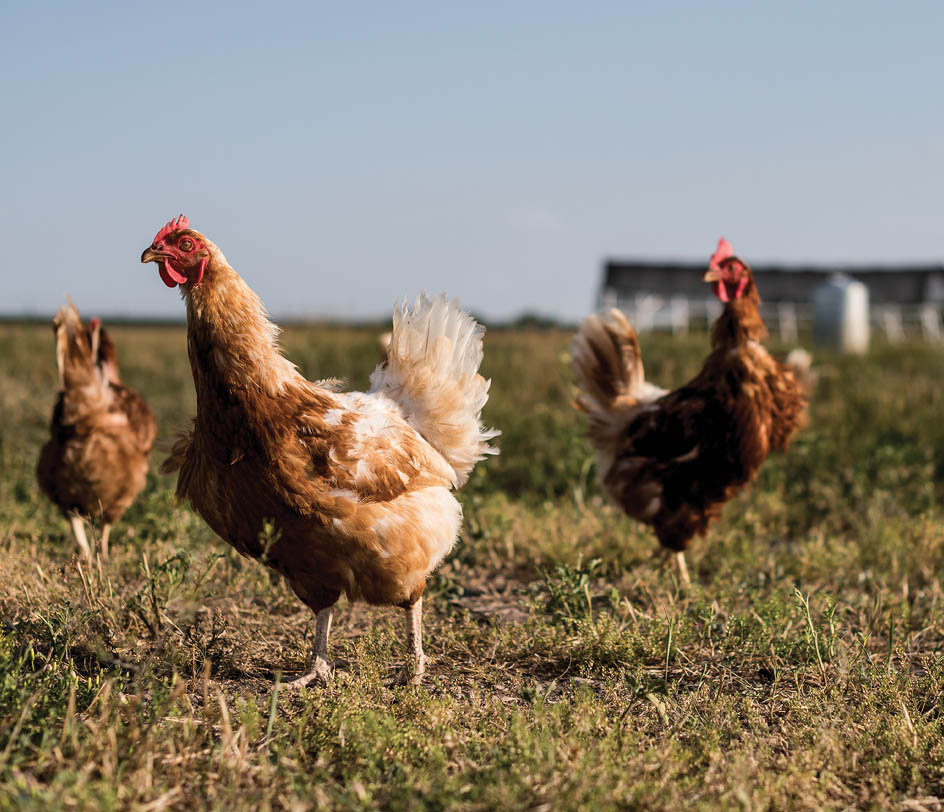
Pasture can provide nutrition for poultry, while poultry manure provides nutrition for the pasture.
One farmer, Joel Salatin of Virginia, bucked this trend toward confinement and pioneered a new system of raising poultry on pasture in movable houses, which protected the birds and also offered nutritional advantage from pastures. Another feature of this system was that Salatin combined cattle grazing and poultry on the same pastures, providing benefits to both poultry and ruminants. The poultry could derive important nutrition from the cattle manure and could also obtain protein by eating the many flies and insects that otherwise bother the cattle. By scratching up the cow pies, the birds scatter the fertility over a wider area and ruin the manure as a habitat for horn fly and face fly larvae.
The poultry receive supplemental feed on the pasture and deposit the fertility contained in that feed in their manure on the pasture, increasing pasture fertility and growth. This system was described in Salatin’s book Pastured Poultry Profits and should be required reading for anyone who wants to raise pastured poultry. Since the publishing of that book, many people have stood on Salatin’s shoulders and expanded and improved on his ideas.
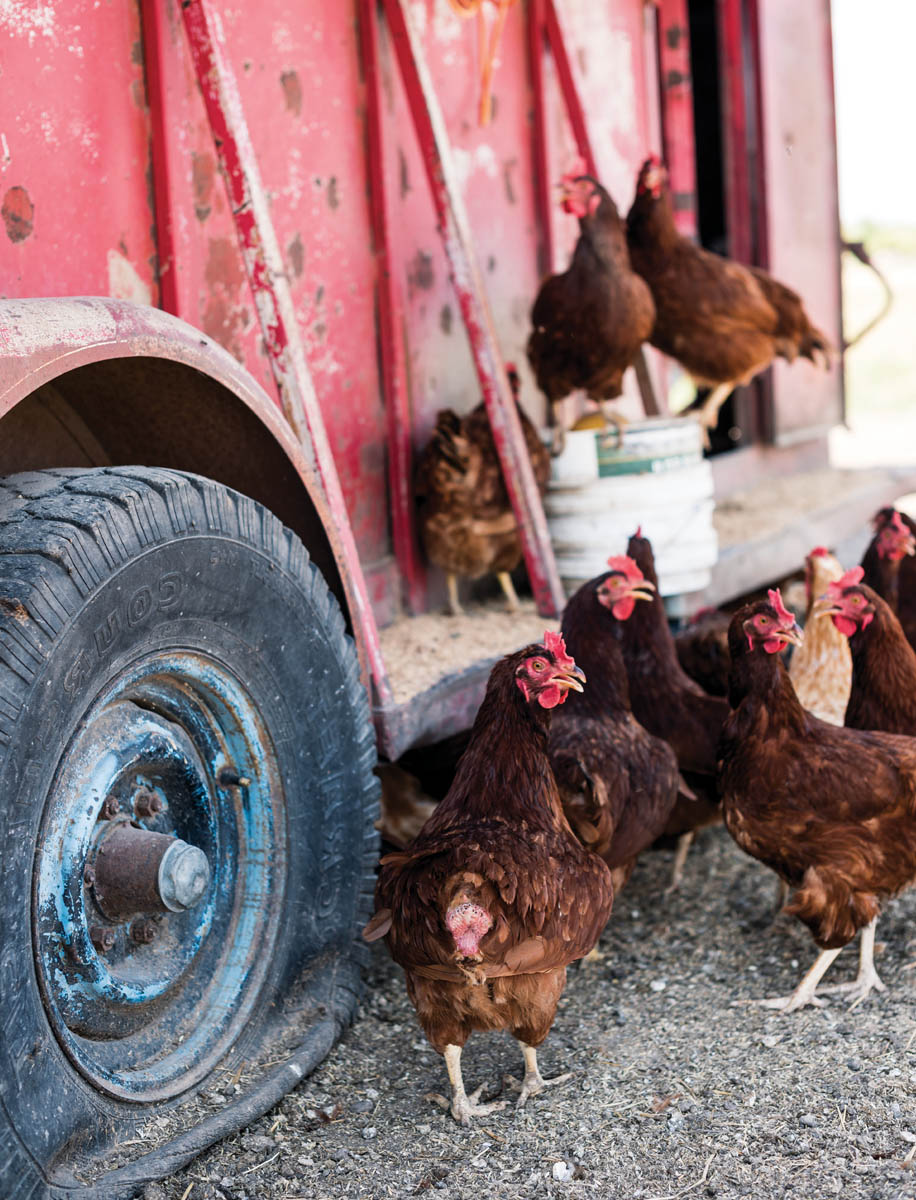
Poultry can be raised in the smallest of pasture settings, even in a backyard, and is by far the cheapest pastured livestock enterprise to initiate. This has made it a favorite of beginning homesteaders and urban expatriates.
The utilization of lightweight, easily movable protection has been the real game changer for producing pastured poultry. Mobile protection should exclude predators, both four-legged and avian. Lightweight nylon netting stretched overhead can keep hawks and owls out. Keep ground-bound predators out by running lightweight, solar-powered electric fencing around the edges of the facility. The other necessities for pastured poultry are shade in the heat of summer and supplemental feed and water.
There are quite literally hundreds of designs for mobile poultry houses. They range from small enough to fit in a suburban backyard to the size of a hay barn.
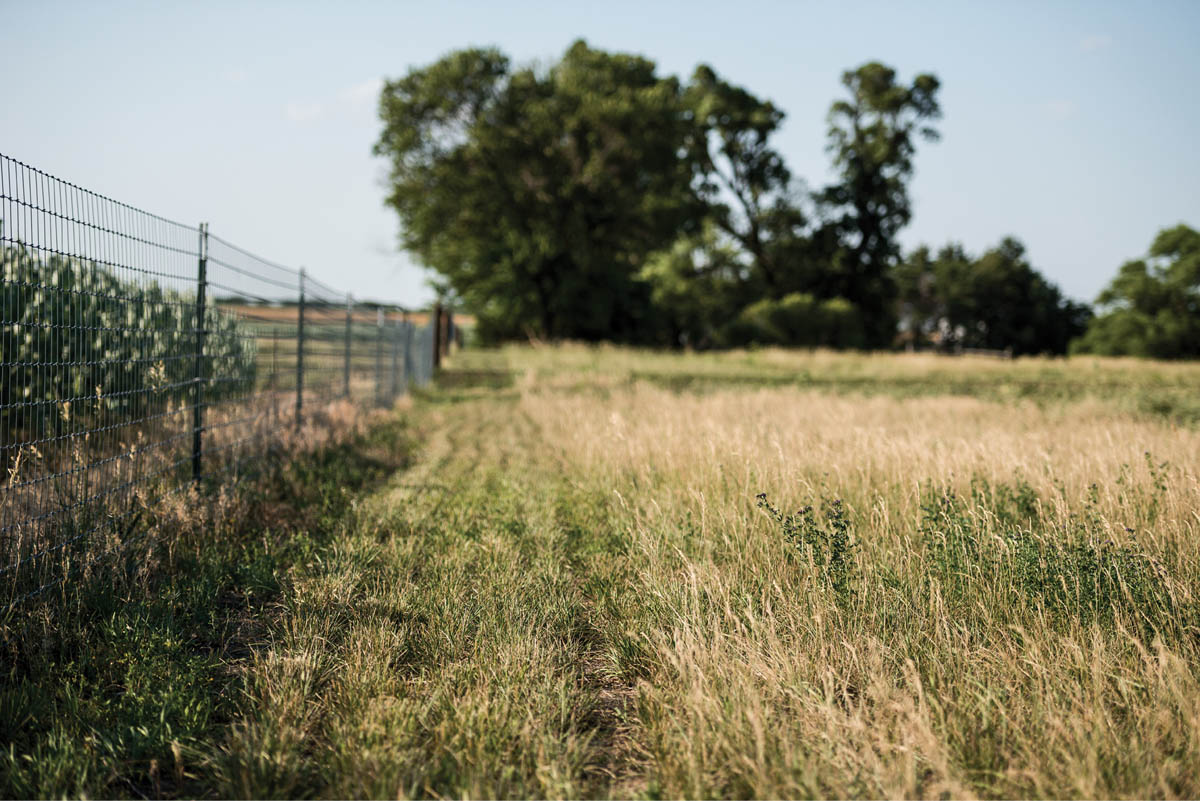
Predatorproof fence for poultry
It is important to realize that poultry are monogastrics and cannot derive much energy from pasture grass itself, though they do eat some and get some important vitamins and minerals from it. A bigger contributor to the birds’ nutrition is the insect and weed seed population present in the pasture, along with the ruminant manure from copastured livestock. Muscovy ducks in particular are renowned for their ability to catch flies on pasture.
Nevertheless, it will still be necessary to provide the bulk of the pastured birds’ feed in the form of grain. This grain probably will need to be imported to the pasture, but it may be possible to grow a fair number of seed-producing annuals in a pasture setting (see chapter 10), and poultry may be used to glean spilled grain on harvested cropland. Birds are ideal scavengers of grain left over after larger animals harvest grain crops, because they can easily pick up individual kernels of grain (as discussed in chapter 15).
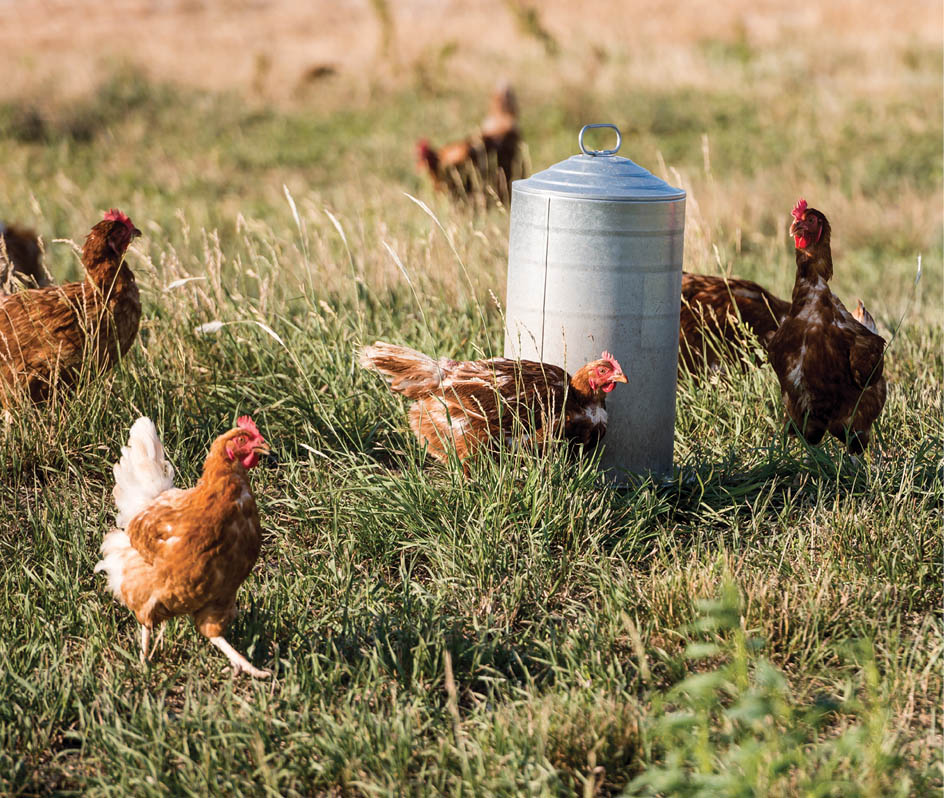
Pastured poultry still require grain in addition to the grass, insects, and seeds they eat.